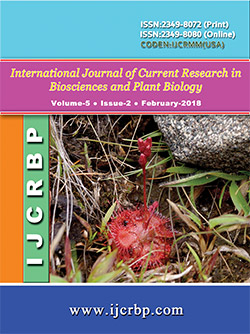 |
Online ISSN : 2349-8080 Issues : 12 per year Publisher : Excellent Publishers Email : editorinchiefijcrbp@gmail.com |
2Department of Soil Science and Agricultural Chemistry, Palli Siksha Bhavana, Visva-Bharati, Sriniketan – 731 236, West Bengal, India
Microbial communities play a vital role in functioning of plants in respect to their growth and development. The activity of rhizospheric microbial community is higher than the surrounding environment. Microorganisms are colonizing near the plant roots thus affecting their growth and development either by promoting growth or developing diseases. Soil borne pathogens are commonly associated with causing diseases in the plant. Naturally occurring beneficial microbes may inhibit their growth and retention in soil. These beneficial microbes may serve as an agent to suppress these diseases in that particular soil. Therefore, greater emphasis has been laid on manipulation of cropping system to manage native beneficial microorganisms as a means to suppress soil borne plant pathogens. The mechanism following this suppressiveness might be due to various biological attributes like production of antibiotics, competition for nutrients and space, parasitism and predation. Natural biological suppression of soil-borne diseases is a function of the activity and composition of soil microbial communities. Many soils possess similarities with regard to microorganisms involved in disease suppression, while other attributes are unique to specific pathogen-suppressive soil systems. For example, non pathogenic Fusarium spp. and fluorescent Pseudomonas spp. play a critical role in naturally occurring soils that are suppressive to Fusarium wilt. Suppression of take-all of wheat, caused by Gaeumannomyces graminis var. tritici, is induced in soil after continuous wheat monoculture due to presence of fluorescent Pseudomonads with capacity to produce the antibiotic 2,4-diacetylphloroglucinol. Rhizoctonia root rot caused by Rhizoctonia solani may be suppressed by specific fluorescent Pseudomonad genotypes with antagonistic activity toward this pathogen. The enhancement of soil suppressiveness using organic amendments has also been widely described, especially for soil-borne diseases. However, there is great variability in the effectiveness of suppression depending on the nature of the amendment, the crop, the pathogen, and the environmental conditions. Moreover managing soil physico-chemical properties also suppresses certain pathogen thus improving soil health and quality. Managing soil parameters and microbial communities also proved to be suppressing weeds. Methods that transform resident microbial communities along with improving soil health and quality in a manner which induces natural soil suppressiveness have potential as a component in environmentally sustainable systems for management of soilborne plant pathogens.
